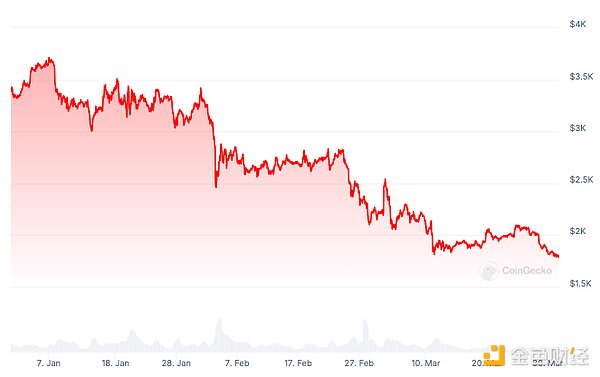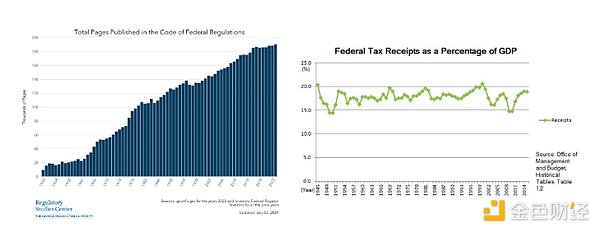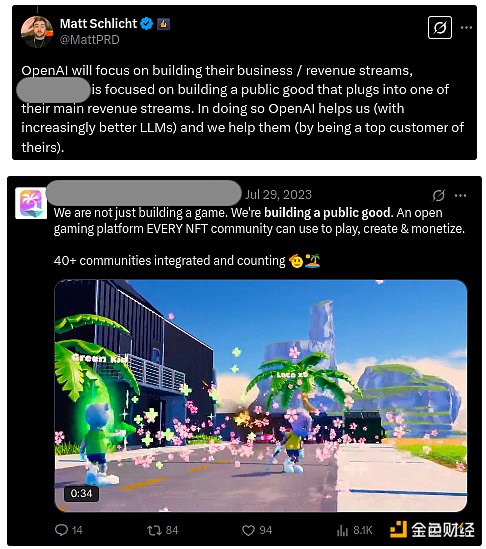Vitalik doesn't particularly care about the price of ETH.
Compiled by: Golden Finance
When ETH continued to fall, and when many users shouted "Fix your eth" under Vitalik's tweet, people were very curious. As the founder of Ethereum, what was Vitalik thinking?

ETH falls below $1,800 Source: Coingecko
On March 29, 2025, Vitalik published two blog posts in a row, which revealed his current thoughts. Obviously, Vitalik does not care much about the price of ETH.
The following are two new blog posts published by Vitalik recently:
First, the tree-ring model of culture and politics
One thing that often puzzled me when I was growing up was the oft-repeated claim that we lived in a "deep neoliberal society" that placed a high value on "deregulation." I was confused because while I saw quite a few people advocating for neoliberalism and deregulation, the actual state of government regulation, in general, was very different from anything that could reflect those values. The total number of federal regulations just kept growing. KYC, copyright, airport security, and a variety of other rules kept getting tighter. U.S. federal tax revenue as a percentage of GDP has remained roughly the same since World War II.

If you tell someone in 2020 that in five years, either the US or China will lead in open source AI, and the other will lead in closed source AI, and ask them which one will lead where, they will probably stare at you as if you are asking a trick question. The US is a country that values openness, China is a country that values closure and control, and US technology in general tends to be more open source than Chinese technology. Come on, it's obvious! However, they are completely wrong.
What’s going on? In this post, I’ll offer a simple explanation I call the Tree Ring Model of Politics and Culture:

The model is as follows:
- How a culture approaches novelty is a product of the attitudes and incentives that prevail in that culture at a particular time.
- How a culture treats old things is primarily influenced by status quo bias.
Each period adds a new ring to the tree, and as the new ring forms, people's attitudes towards new things are formed. However, soon, these boundaries will be fixed and difficult to change, and new rings will begin to grow, affecting people's attitudes towards the next wave of topics.
We can analyze these and other situations through the following perspectives:
- There was indeed a trend toward deregulation in the US, but it was most pronounced in the 1990s (if you look closely, you can actually see this in the chart!). By the 21st century, the tone had shifted toward increased regulation and control. However, if you look at specific things that “matured” in the 1990s (such as the Internet), you’ll see that they were eventually regulated based on the principles that dominated in the 1990s, which gave the US (and much of the world, due to imitation) decades of relative Internet freedom.
- Taxes are constrained by budgetary needs, which in turn are largely determined by the needs of health and welfare programs. The “red lines” in this regard were set 50 years ago.
- All moderately dangerous activities involving modern technology are considered by both the law and the culture to be more suspicious than activities such as dangerous mountaineering, which has a very high mortality rate. This can be explained by the fact that dangerous mountaineering is something people have been doing for centuries, and attitudes harden when general risk tolerance is much higher.
- Social media matured in the 2010s, with a cultural and political shift toward viewing it as part of the internet on the one hand, and as a distinct thing on the other. As a result, restrictive attitudes toward social media generally don’t carry over to the earlier internet—despite the general growth of internet authoritarianism, we haven’t seen particularly strong attempts to crack down on unauthorized file sharing.
- As AI matures in the 2020s, with the United States as the leading power and China close behind, it is in China’s interest to pursue a “complementary commoditization” strategy on AI. This intersects with the generally supportive attitude of many developers toward open source. The result is an environment of open source AI that is very real, but also quite AI-specific; older areas of technology remain closed, like walled gardens.
More generally, the implication here is that it’s hard to change the way a culture treats things that already exist, and about which attitudes have already solidified. What’s easier is to invent new patterns of behavior that override old ones, and to try to maximize our chances of getting good norms. This can be done in a number of ways: developing new technologies is one, using (physical or digital) communities on the internet to experiment with new social norms is another. To me, this is also part of the appeal of the crypto space: it provides an independent technological and cultural foundation to do new things, without being overly burdened by the existing status quo biases. We can bring life to the forest by planting and nurturing new trees, rather than planting the same old ones.
Second, we should talk less about public goods funding and more about open source funding
One topic that has long been close to my heart is how to fund public goods. If there is a project that provides value to a million people (and there is no fine-grained way to choose who gets the benefit and who doesn’t), but everyone gets only a small portion of that benefit, then it’s likely that no one will feel it’s in their interest to fund the project, even if the project is very valuable overall. In economics, the language of “public goods” is a century old. In digital ecosystems, especially decentralized digital ecosystems, public goods are extremely important: in fact, there are good reasons to suggest that the average good that one might want to produce is a public good. Open source software, academic research on crypto and blockchain protocols, publicly available educational resources, and many more are all public goods.
However, the term “public goods” faces significant challenges. In particular:
1. The term "public good" is often used in public discourse to mean "a product produced by the government," even if it is not a public good in the economic sense. This can cause confusion because it creates the perception that whether a project is a public good does not depend on the project itself and its attributes, but on who is building it and what their stated intentions are.
2. There is a widespread belief that public goods funding lacks rigor, operates based on social desirability bias (sounds good, not actually good), and favors insiders who can play social games.
To me, these two issues are related: the term “public good” is susceptible to social gaming in large part because the definition of “public good” is so easily expanded.
Let’s see what happens when we search the phrase “building the public interest” on Twitter. I did it right now, and here are some of the first results:

You can keep scrolling and find many projects describing themselves using the phrase “We are building a public good”.
This is not to criticize individual projects; I don’t know much about either of the above projects, and they are probably both great projects. However, both examples are commercial projects with their own tokens. There is nothing wrong with being a commercial project, and there is generally nothing wrong with launching your own token. However, the term “public good” now seems to refer to just a “project” when it is so easy to water it down to this point.
Open Source
As an alternative to “public goods,” let’s think about the term “open source.” If you think about some of the core examples of what are clearly digital public goods, they are all open source:
- Academic blockchain and cryptographic protocol research
- Documentation, tutorials...
- Open source software (e.g. Ethereum clients, software libraries, ...)
On the other hand, open source projects seem to be public goods by default. You could certainly make a counterexample: if I write a piece of software that is highly specific to my personal workflow and put it on GitHub, most of the value created by the project might still accrue to me personally. However, the act of open sourcing (rather than keeping it secret) is certainly a public good, and the benefits are very diffuse.
One real advantage of the term "open source" is that it has a clear and widely agreed-upon definition. The FSF's Free Software Definition and the OSI's Open Source Definition have been around for decades, and there are natural ways to extend these definitions to other areas beyond software (e.g. writing, research). In the crypto space, the inherently stateful and multi-party nature of applications, and the new centralized vulnerabilities and control vectors these factors imply, do mean that we need to expand the definition a bit: open standards, the insider attack testing presented in this article, and walkaway testing can be valuable additions to the FSF+OSI definitions.
So what is the difference between "open source" and "public goods"? Well, let's let the robot give a few examples:

I personally don't agree at all that examples in the first category are not public goods. A project having a high threshold for contribution does not prevent it from being a public good, nor do the same apply to companies that benefit from the project. Furthermore, a project can absolutely be a public good while the things around it are private goods.
The second category is more interesting. First, we should note that all five of these examples are in the physical space, not the digital space. So if we want to focus on digital public goods, there’s no reason the above examples would be an argument against focusing on just “open source.” But what if we do want to cover physical goods? Even the crypto space has its own enthusiasm for better regulation of physical things rather than just digital things; in a sense, that’s what the cyber state is all about.
Open source and local physical public goods
Here we can make an observation: while providing these things at a local scale is an "infrastructure building" problem, and can be done in either open or closed source ways, the most efficient ways to provide these things at a global scale often end up involving... real open source. Clean air is the most obvious example: a lot of research and development has been done, much of it open source, to help people around the world enjoy cleaner air. Open source can help make any kind of public infrastructure easier to deploy at a global scale. The question of how to efficiently provide physical infrastructure at a local scale remains important - but it's an issue that applies equally to democratically governed communities and companies.
Defense is an interesting case. Here I would make the following argument: if you build a project for defense reasons that you wouldn’t open source, then there’s a good chance that, while it might be a public good locally, it might not be a public good globally. Weapons innovation is the most obvious example. Sometimes one side in a war has a stronger moral reason than the other, and it’s justifiable to help it conduct offensive operations, but on average developing technology to improve military capabilities doesn’t improve the world. The exceptions (defense projects that people would want to open source) might be “defense” capabilities that are actually about defense; an example might be decentralized agriculture, electricity, and internet infrastructure that help people stay fed, functional, and connected in challenging environments.
So, here too, shifting the focus from "public goods" to "open source" seems like the best option. Open source shouldn't mean "building anything is equally noble as long as it's open source"; it should be about building and open sourcing what is most valuable to humanity. But distinguishing between projects that are worth supporting and those that are not is already the main task of public goods funding mechanisms, as is well known.















